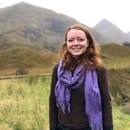Here is some art for thought. Charity Nonkes, a third year Arts and Business student majoring in Peace and Conflict Studies, has taken on artistic creation as her latest conquest. How do you combine work and passion, they ask? You make the work your passion. For her Peace and Environment course final project, Charity is an inspiration for all those out there who are itching to try their hand at visual art. It becomes apparent here that you do not need to be a visual art student to be an artist, or to send a message. Charity’s final project, the sculpture Who Am I On Stolen Land?, stands distinctively in the Grebel Gallery at the Centre for Peace Advancement at the University of Waterloo, forcing passerbys to consider its many symbols. Featuring multiple elements and natural materials, the sculpture transcends your typical thought-provoking three-dimensional art piece. To Charity, the woman’s bust adorned with components of nature is more than a beautiful spectacle, it’s a reflection of her background, perspective, and relationship with the environment. Analyzing further, however, one can identify the message of Indigenous themes, stories, and how the world is connected through the symbols that Charity’s sculpture presents.
What are some key themes of the sculpture?
This art project is an exploration of what living on this land means for me. What does having a relationship with nature mean as I think of my involvement in colonization and reconciliation? There are three main parts to Who am I On Stolen Land? with interconnected stories and themes. The main areas are the holistic worldview (new story), dominant worldview (old story), and the future: connected to each other through the local Maitland River and Grand River.
What are the explanations for the three main views you mentioned?
The holistic worldview explores my personal relationship with nature with a focus on my family history and its part in colonization. The dominant worldview serves as a testament to what we are doing to the world and a warning to the University of Waterloo in its quest for innovation. Ideas are often rooted in good intentions but serve a negative end. Innovation can be a part of the answer but it will not solely save us. The future considers both the holistic and dominant worldview as it decides what choices it will make.
What do you hope the audience will take from this piece?
The piece asks the audience to consider their relationship with nature and recognize how connected to the world they are.
What was the process to begin creating this sculpture?
This piece came from numerous drafts. I had a hardened casting of my bust made at an event at the UWaterloo Women’s Centre in my first year, and I recognized that I could make use of it once I came up with the idea for this project. I wanted this piece to be a reflection and discovery of my personal relationship with the environment. I did so by using my own body for the sculptured part. I then took a mold of my face and back, and began collecting garbage, pieces of nature, and pressing flowers.
Could you explain a few of the pieces of the sculpture?
The base of the sculpture is a wooden cutout from a tree from a forest my family owned for generations, particularly drawing from the influences of my grandmother, and focusing on the idea of how I, as a person, came from my ancestors.
The chains represent the Haldimand Tract, running ten kilometres along the Grand River. This was land promised to the Six Nations and land that was taken by settlers. The chains symbolize confinement, and the loss of original Indigenous territory.
I also represented the Three Sisters, those being corn, beans, and winter squash. This again symbolizes Indigenous influence, and a Holistic relationship with nature.
How long did this creation process take?
The piece took four months to complete.
Can you give me a quick summary of the collective symbolism of this piece?
This piece symbolizes the recognition of how we are treating nature, both in the past and in the future. This piece is to encourage the viewer to recognize their personal relationship with the environment. Also, I wish for it to challenge the University of Waterloo’s focus on innovation. Innovation is not a one and only solution.
Charity is active in several groups and discussions on campus, her main passion and focus being in her work with the Indigenization Strategy Working Group. This campus group works largely on a multitude of topics, namely developing responses to calls for action of the Truth and Reconciliation Commission (TRC) of Canada, and advising UWaterloo’s President, Provost, and senior management on the development of a university Indigenization Strategy.
You can follow the Grebel Centre for Peace Advancement via their Twitter handle @GrebelCPA. Feel free to view Charity’s sculpture at Conrad Grebel University College on the South of UWaterloo campus.

